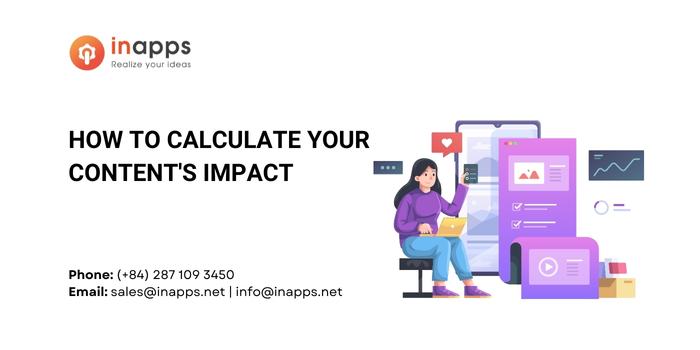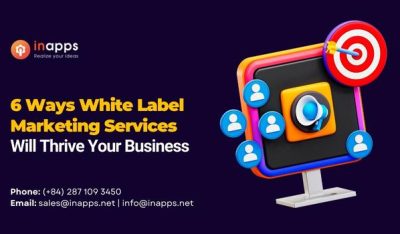- Home
- >
- Inbound Marketing
- >
- How to calculate your Content’s impact quickly
How to Quickly Calculate Your Content’s Impact is an article sent to you by the InApps editorial team. Hope readers will have more useful knowledge at www.inapps.net
I admit – measuring the ROI of various marketing efforts has never been easy.
There are simply too many touchpoints, channels, and other variables in the process to accurately credit results to specific campaigns.
But I’m sure you’ll agree that when it comes to tracking content marketing ROI, things get even more complicated.
For one, content attracts the top of the funnel traffic, visitors who focus on researching their problem, rather than evaluating available solutions.
And although many of these people might eventually convert into sales-ready leads and customers, correlating their behavior with the content they’ve read or seen might seem practically impossible.
Luckily, it’s not.
And in this post, I’ll show you a simple strategy that will help you measure the ROI of content marketing, and evaluate how well content supports your company’s goals and objectives.
Intrigued? Then let’s get started.
Why We Struggle So Much With Measuring and Attributing the ROI of Content?
Let’s begin by putting the problem into a wider perspective.
According to MarketingProfs, only 26% of marketers admit to being able to track the content marketing ROI.

(image source)
And if you review the Content Marketing Institute’s Benchmark Reports from the last couple of years, you’ll notice the challenge coming up on every issue.
Here, let me show you. The 2016 report:

(image source)
A year before that, only 21% of marketers rated their organization’s ability to track the ROI of content as successful.

(image source)
The challenge came up in 2014 report too:

(image source)
And yes, if you look at the 2013 edition, it’s there as well.
At the same time…
CMI’s Reports confirm that properly measuring the content’s effectiveness is one of the key factors that differentiate the content top-performers from laggards.

(image source)
But why reporting on content’s effectiveness poses such a challenge?
There are actually two reasons:
Firstly, because of the place of content in the sales funnel.
Content is a top of the funnel (TOFU) activity. Blog posts, guides, and other content types help attract people at the discovery stage of the buying cycle when they focus more on their problem, rather than any available solution.
And so, this content’s objective is to bring qualified traffic to the site and help them discover you, instead of convincing anyone to buy.
As the guys at Pardot wonderfully put it:
“As a marketer, your job at this stage is to create awareness of your product, service, or company, so that your buyers begin to understand what you do, and how you can help them. Content should be focused on your buyer’s pain points — not your product or brand.” (source)

(image source)
Naturally, in time, many of those visitors might end up buying from you. However, by then, they’d typically used multiple channels, aside from content, during their journey to purchase.
The complexity of this process makes it so challenging to quantify how much an article, infographic or an eBook has influenced someone’s decision to learn more about your business.
And secondly, because we often look at measuring the content’s ROI wrong.
For example, we use irrelevant metrics. As Cathy McPhillips writes over at Content Marketing Institute’s blog (note, the emphasis in bold is mine):
“While some vanity metrics (e.g., Twitter followers, website traffic) are easy to track, they are rarely that insightful independent of other data. We do track our social growth, which allows us to look at trending and anecdotal information on where we are getting the most shares and social conversation. However, we have found it’s more important to track conversions to email and topics of interest. “
In other words, what Cathy’s saying is that to attribute the impact of content on the ROI properly, you need to stop looking at the final conversion (i.e. a sale), and focus on specific actions that push visitors deeper into your funnel (i.e. email signup).
And that’s the premise of the strategy I want to show you today.
So, let’s talk about it now.
Here’s How to Quickly Measure the Impact of Any Content You Publish
In a nutshell, the strategy works like this:
You need to define the next action you want your visitors to take after reading the content. And then measure how many of them actually take it.
Before I explain it in more detail though, let me show you examples how businesses are already implementing it.
For instance, marketers at Snappa, a graphic design tool, want readers to learn more about their product. And so, to entice them to do that, they place calls to action in each blog post that take visitors to the homepage.

Of course, I can only assume it, but I believe that they monitor the call to action’s click-through rate to assess their content’s performance.
Drift is another company that uses the blog to move visitors to their homepage by using relevant calls to action:

Another example. A company behind this blog identified a webinar registration as their next step in the funnel. As a result, they use calls to action to attract visitors to register for a session.

Again, I only guess here, but it would seem logical that they track webinar registrations as the indication of their content’s performance.
To use this strategy as well, you first need to understand your sales funnel, and how content can help move visitors from one buying stage to another.
Should you entice readers to sign up to a newsletter?
Visit other posts?
Or maybe download a lead magnet and join your mailing list?
Here’s how you can quickly find out.
Step 1. Revisit your original goals for the content strategy
Think about what are you using content for.
Do you want to increase relevant traffic to the site and build an audience? Boost your brand awareness? Or perhaps you want content to help you build your industry authority?
Note that I deliberately didn’t include goals like increasing sales or revenue on the list. And the reason for that is simple – the majority of the content focuses on attracting the top of the funnel audience.
Sure, you could try to move these visitors to the home page (just like some of the companies I’ve shown in the examples above). But the success of such strategy would depend on how well it fits into your sales process.
However, if you sell products that require a longer purchase cycle, then, it might make more sense to first aim at a micro-conversion, such as joining a mailing list.
Step 2. Define what visitor actions would help reach that objective
This is by far the most important step of the process.
With your objective (or objectives) at hand, consider what reader actions would help you achieve it.
For example:
If you aim to grow your traffic and build an audience, then, those actions could include checking out your other content, returning to the site or joining your email list.
Visiting the homepage would help visitors understand more about what you do, and how you deliver value to clients. However, as I mentioned earlier, this step might not work that well if you sell products or services with a long purchase cycle.
At the same time, enticing readers to download your lead magnet will allow you to grow your audience, and nurture them into potential clients.
Step 3. Select specific KPIs associated with the next action
Finally, define how you’re going to measure the impact of content on that particular action you’ve identified in the previous step.
In other words, pick one or two metrics that will help you assess if your content’s moving visitors to the next step.
Here are sample KPIs for the examples above:
| Goal | Next Actions | KPI |
| Grow traffic and audience |
|
|
| Brand awareness | Visiting the homepage | Call to action’s click through rate Visits to the homepage from the blog |
| Lead generation | Downloading lead magnets | Lead form impressions Conversion rate |
Wrapping up
Naturally, there are more complex attribution models to help measure content marketing ROI.
(For example, here’s one that uses advanced technology to measure first click and first touch to assess the content’s ROI.)
This strategy, however, will help you quickly evaluate how well content supports your company’s goals and objectives.
Follow this to make sure you’ve got How to Quickly Calculate Your Content’s Impact. Save and share with those around you these extras.
To learn more about Inbound Marketing
Contact us:
www.inapps.net
Let’s create the next big thing together!
Coming together is a beginning. Keeping together is progress. Working together is success.




















